Work on the Mayan Train route yielded extraordinary discoveries

Work on the Mayan Train route yielded extraordinary discoveries
Reyes Martínez Torrijos
La Jornada Newspaper, Thursday, July 17, 2025, p. 2
Anthropologist Diego Prieto's tenure at the head of the National Institute of Anthropology and History (INAH), which began in August 2016 and concluded yesterday, has yielded a tremendous harvest of successes, including the magnificent archaeological rescue work along the Maya Train route, the creation or renovation of museums around archaeological sites linked to the railway project, and the reconstruction of cultural heritage affected by the 2017 earthquakes.
The rescue project was, as Prieto called it, the most important research project
ever carried out in the Mayan region of Mexico, involving 500 specialists—including archaeologists, anthropologists, historians, and restorers—and dozens of extraordinary discoveries.
The largest, without a doubt, due to its scope and reach, in addition to the number of professionals and workers involved in this task
, the researcher also mentioned.
Nearly 63,000 construction elements, 2,011 movable assets, more than 1.8 million ceramic fragments, 840 human remains, and more than 2,600 pieces under restoration were recorded and preserved around the railroad on the Yucatán Peninsula.
In addition to the rescue efforts along the 1,500-kilometer Maya Train route, resources were allocated for numerous research seasons and restoration work at many of the fifty archaeological sites located nearby.
The research allowed for an enrichment of the existing understanding of the important and ancient pre-Hispanic civilization established in southeastern Mexico and confirmed the enormous population density that existed in the Yucatán Peninsula and the Mayan jungle before the Conquest.
Although the salvage work is complete, the discovery of thousands of artifacts and the recording of Mayan settlements along the project's boundaries will require years of work to systematize the data and insights generated by this colossal undertaking.
In connection with the Mayan Train, museums were renovated or built in Palenque, Ruta Puuc (Kabah), Dzibilchaltún, Chichén Itzá, Costa Oriental (Tulum), and Calakmul, and have been operating since last year. In addition, the sites of Ichkabal ( La Jornada , 10/12/22) and Paamul II were decided to open.
Julia Margaret Cameron on display at the Teatro Real
The 19th-century photographer was inspired by Shakespeare's works to create her images.
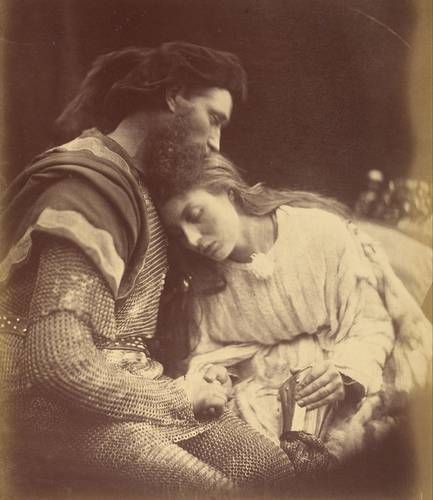
▲ The Farewell of Sir Lancelot and Queen Guinevere (1874), by Julia Margaret Cameron. Photo ©PhotoEspaña and ©Javier del Real/Teatro Real
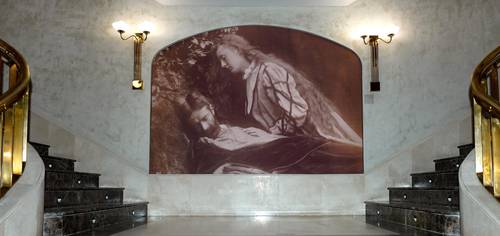
▲ A photo of him adapted for the Teatro Real in Madrid. Photo ©PhotoEspaña and ©Javier del Real/Teatro Real
Armando G. Tejeda
Correspondent
La Jornada Newspaper, Thursday, July 17, 2025, p. 3
Madrid. Julia Margaret Cameron emerged as one of the most important photographers of the 19th century, despite beginning her career at the age of 48, when her daughter gave her a camera. As part of the PhotoEspaña festival, Madrid's Teatro Real is exhibiting a series of images she created and took, inspired by the literary works of William Shakespeare. Cameron was a pioneer of photographic portraiture and a precursor to the use of images as poetic and theatrical representation.
The Teatro Real has begun a season featuring Shakespeare's most popular plays, with four operas and a ballet: The Faerie Queene by Henry Purcell; Otello by Giuseppe Verdi; Romeo and Juliet by Charles Gounod; A Midsummer Night's Dream by Benjamin Britten; and the dance performance Juliet and Romeo by the Royal Swedish Ballet.
Cameron was born in Calcutta in 1815 and died in Kalutara, Sri Lanka, in 1879. The exhibition brings together a carefully curated selection of works from his archive, many of them directly inspired by Shakespeare's world, as was common in the British avant-garde trends of the time. The images depict scenes typical of the period, although he also portrayed famous intellectuals such as Charles Darwin and Lord Tennyson, as well as anonymous figures from his home environment.
“The exhibition celebrates the artistic legacy of a visionary woman, a pioneer of staged photography and one of the first to assert photography as an artistic discipline in its own right. Cameron weaves an allegorical dialogue with literature, the Renaissance, and biblical imagery, creating scenarios where the great themes of human history—beauty, tragedy, love, truth—are masterfully expressed through light, gestures, and gazes,” explained Joan Matabosch, artistic director of the Teatro Real, during the presentation.
María Santoyo, director of PhotoEspaña, elaborated that “Cameron's style broke with the technical canons of his time, and the lack of sharpness, the blur effect, and the smudges of his fingers are characteristic signatures of his work, making it ahead of its time, anticipating photographic pictorialism itself. The defense of the aesthetic over the technical, of the poetic over the real, are a manifestation of his vision, which prioritizes artistic creation as photographic praxis over the dominant trend of documentary photography.”
Cameron's work has endured despite the disdain of many of her contemporaries and has established itself as one of the most influential of the 19th century. It is worth highlighting that "the intensity and emotionality of the stage present in Julia Margaret Cameron's photographic imagery, her sensitivity, her ability to capture the ethereal, her taste for beauty, her almost iconographic portraits, whose aura sometimes borders on the sacred—contrasting the drama of the poses with the simplicity of the props—make this artist an eternal interlocutor with theater, music, and poetry, worthy of constant revisiting," explained Sylvia Edvinsson, director of the British Council Spain, who collaborated on the exhibition.
The most significant works of La Buena Impresión will be exhibited.
The Oaxacan lithographic workshop seeks to make its collection a symbol
of the country's contemporary art.
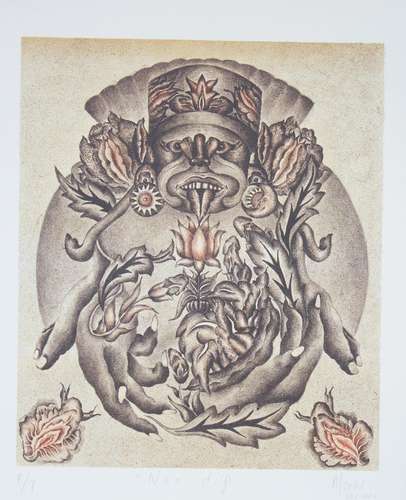
▲ Nan Dix , a lithograph by Gabriela Morac included in the exhibition Stone and Image: Work by La Buena Impresión , which opens on the 25th at the IAGO. Photo courtesy of La Buena Impresión
Merry MacMasters
La Jornada Newspaper, Thursday, July 17, 2025, p. 4
The aim of La Buena Impresión's collection is to be a glimpse
into contemporary art in Mexico, says Fernando Aceves Humana, co-founder of the Oaxacan lithographic workshop in 2019. In Piedra e imagen: Obra de La Buena Impresión , an exhibition of 65 pieces that will open on the 25th at the Oaxaca Institute of Graphic Arts (IAGO), a selection of around one hundred artists of all sizes will be offered, from the most renowned to those just starting out, who have participated in the workshop located in the Historic Center of the Oaxacan capital.
The workshop received a major boost
from Francisco Castro Leñero (1954-2022), one of its founders, Aceves Humana recalls. La Buena Impresión is the continuation of the engraving project they conceived for Cambodia, a country where they intended to bring a printing press. However, as the conditions were not met, this project was put together by Daniel Barraza, Castro Leñero, Dr. Lakra, María Miranda, and Guillermo Ramírez Orduña, who trained there. Thus, the Oaxacan workshop was born from the donation of a 1909 Voirin electric lithography press by French artists and printers Julie Gerbaud and Patrick Devreux.
When the workshop was founded, the idea was to expand the printing industry in the state to include rural and urban communities, offering classes and supporting budding engravers in setting up their own workshops. We currently operate in Santo Domingo Yanhuitlán, where we have set up a permanent independent lithography workshop run by the community's youth. We installed a printing press that a donor helped us repair
.
After five years of teaching in the town alongside architect Pedro Pizarro, Pizarro informed him of a lithographic precedent: “There is a stone that belongs to the community, which has a drawing of Christ, the Lord of Ayuxi. It was commissioned between 1850 and 1880; it was made by a Mr. Santana, a draftsman/printer, but the residents had it ever since because they decided to buy the stone; they had liked it very much. It was lost for a time, although, thanks to the project, Daniel Barraza restored it and reprints were made and sold in the community. In Yanhuitlán, the lineage of draftsmen goes back a long way—the Yanhuitlán Codex is from there. This is thanks to the Museo Comunitario Rastros y Rostros (Traces and Faces Community Museum) (founded in 2014). Pizarro and Proyecto Yivy have greatly promoted this.”
Presses that create community
Currently, Aceves Humana teaches classes in Pluma Hidalgo, the center of the coffee-growing region: It's very mountainous, and there's a lot of landscape to paint. We're trying to create a school there, hoping that one of our students will become a recognized artist. Printing presses create a community, and that's why we always promote printmaking to encourage students to start a workshop
.
Another goal has been to attract artists to work at La Buena Impresión. Some students from Columbia University came to train with us. We just finished an edition for the Museum of Contemporary Art in Cleveland, which commissioned a piece from the American artist Nicola López. I was invited to give a lecture at the University of Austin. Jean Pierre Tanguy, curator of the 21st edition of the Sarcelles Biennial in France, invited me to co-curate the exhibition. La Buena Impresión convened and arranged for the submission of works by 20 selected artists, including Saúl Villa and Sergio Hernández. The workshop is becoming a hub for education and specialization in lithography
.
Aceves Humana expresses its satisfaction with the exhibition at the Iago, as it is a place that has been exemplary and has educated us all
.
Stone and Image: Work of La Buena Impresión will be exhibited from July 25 to October 26 at the Oaxaca Institute of Graphic Arts (Macedonio Alcalá 507, Oaxaca).
Staging channels uncertainty into action
Bonsai emerged as a response to the disruptions caused by the pandemic
Daniel López Aguilar
La Jornada Newspaper, Thursday, July 17, 2025, p. 4
Supernatural beings, guardians of a cosmos on the brink of collapse, question humanity's survival on a planet that seems to have lost its patience. What happens when the human essence distances itself from its own nature?
This reflection is raised in Bonsai, the debut film by the Physical Theatre Company, which constructs a visual poetic approach to show the fragility of human existence.
The premiere will be today at 8 p.m. at the Arts Forum of the National Center for the Arts (Cenart), with a cast made up of graduates of the National School of Theatrical Arts.
The project was born in response to the disruptions caused by the pandemic and serves as a collective refuge for a generation of artists seeking to create and maintain their own creative platform.
For Alejandro León Espinosa, artistic director and one of the protagonists, the creation of this company arose from an urgent need: to channel uncertainty into action.
The COVID-19 pandemic abruptly interrupted our academic preparation, but it also prompted us to ask ourselves what we could do for ourselves
, she noted in an interview with La Jornada . The path isn't easy, especially when those who already have recognition are privileged
.
The plot unfolds in a fantastical universe where the environment takes on unusual shapes and sounds: a jaguar, a hummingbird, a dolphin, and an eagle represent these protectors of the cosmos. They face a crossroads: the Earth must be destroyed to preserve its essence, as the natural environment shows signs of exhaustion in the face of human indifference.
The body communicates what words cannot reach.
From the first days of rehearsal, under the direction of Hugo M. Bolaños, the group explored the community with exercises that allowed them to adopt natural aspects such as rain, earthquakes, and storms.
Improvisation was key to our creative process
, added León Espinosa (Tuxtla Gutiérrez, Chiapas, 1991). It pushed us to be a force of nature, to communicate with our bodies what words can't
.
The show brings together six performers on stage: Andrea Lara, Andrea Aguilera, Andrea Cedeño, Citlali Chong, Ximena Sotomayor, and Alejandro León himself. A puppet, manipulated by Natalia Leza, plays the surviving child, a symbol of hope and uncertainty.
The stage design maintains the atmosphere of rebirth and fragility: the floor evokes the bark of a tree that has seen the passing of seasons. Two transparent fabrics, embroidered with plants and flowers, suggest the earth in transition, between death and rebirth.
The instrumental music chosen by Bolaños accompanies the movement and marks the pulse of a planet that breathes and suffers alongside its inhabitants.
The body acts as an instrument to tell a story that transcends verbal discourse. Alejandro León recalled that his training at the National School of Theatre Arts always included movement as an essential language.
"We don't just pay attention to words; we also learn to observe others, to feel their presence. This creates a collective fabric where everyone contributes from their own sensitivity. This horizontality is key to balancing direction and action, thanks to constant communication and the division of tasks.
"I hope this production reflects something of the experience of those who attend, especially the young people who, like us, experienced isolation. I want them to see that projects are possible, that this space welcomes new voices, and that theater can be an act of resistance."
“There's still time to save the planet. When I see a tree, I feel like I'm part of something bigger, a nature we mustn't forget. Asphalt, cars, excessive consumption... everything points to a path that threatens what we love. The Earth is a living system that, sooner or later, will decide to say enough,” he concluded.
The Bonsai season begins today and concludes on the 27th, with performances on Thursdays and Fridays at 8 p.m., Saturdays at 7 p.m., and Sundays at 6 p.m. at the Cenart Arts Forum (Río Churubusco 79, Country Club Churubusco neighborhood).
Tickets cost 150 pesos, with a special promotion on Thursdays for 30 pesos and 2 for 1 on Wednesdays for online purchases.
The Estanquillo showcases the greatness of the miniatures by artisan Roberto Ruiz
Merry MacMasters
La Jornada Newspaper, Thursday, July 17, 2025, p. 5
The writer and journalist Carlos Monsiváis (1938-2010) was a passionate collector of the miniature sculptures of Oaxacan artisan Roberto Ruiz (1928-2008). Over the years, he acquired hundreds of these carved and sculpted bone objects, depicting a variety of themes, from skeletons, catrinas, archangels, and devils to religious images, national heroes, and scenes from everyday life inspired by the artist's homeland.
He even wrote a book about the 1988 recipient of the National Prize for Sciences and Arts in the area of Arts and Traditions. For Monsiváis, Ruiz's obsession
with skulls "stems organically from his search for essential forms, for rigorous presentations of the popular and the traditional. Displaying his sensitivity in variegated ensembles (where the forced promiscuity of the figures engenders unexpected couplings, lines of sensuality that birth offers), he also uses the most orthodox motifs, the landscapes of costumbrismo, the amorous love of even-numbered couples
. While the themes vary, the constant is the attitude of maestro Ruiz, who deeply immerses himself in each piece and never compromises in intensity or imaginative power."
Apparently, the only teacher Ruiz recognized was José Guadalupe Posada.
In 2008, the Museo del Estanquillo (Carlos Monsiváis Collections Museum) dedicated an exhibition to him. Now, the museum returns to the theme with the presentation of Roberto Ruiz: Giant of the Miniature , featuring more than 600 pieces, all collected by the writer. The Estanquillo Museum houses the largest collection of miniature sculptures by the man who developed his body of work in Ciudad Nezahualcóyotl. The works span from 1960 to 1990.
Born on March 2, 1928, in Miahuatlán, Ruiz studied through the second year of primary school. At the age of 6, he began playing with clay, which he collected from the floor of a pottery workshop across the street from his house, to mold figurines. At 9, he turned to wood. When he was sent to shepherding, he amused himself by making wooden figures from what he saw in the fields, using sharp tools, a machete, or a knife.
Family pressures forced him to work, and in the kitchen of a bakery, he discovered his future career, turning bread dough into figures. At school, instead of doing what his teacher suggested, he filled his notebook with drawings. He never stopped making his figurines, budding miniatures of dancers, Tehuanas, and nativity scenes.
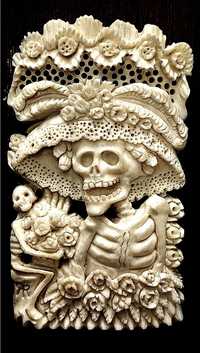
▲ La Catrina , a bone sculpture by Roberto Ruiz. Photo taken from the Museo del Estanquillo Facebook page.
Around 1943, the teenager traveled to the city of Oaxaca to sell his creations. At some point, he realized that his sensitivity, manual skill, and the tools he had weren't enough to make more elaborate works. He then toyed with the idea of attending school to better learn what he did in a rustic way, but such a school didn't exist.
Faced with his poor life prospects, Ruiz moved to Mexico City in search of his dream school. He settled in the Las Palmas neighborhood of Ciudad Nezahualcóyotl, married, and gradually developed and explored his own imagination. With complete mastery of the tools and instruments common in dental workshops, he began to make new miniatures more in tune with his interests. He distanced himself from the stereotypes and typicalities
so in demand in artisan shops and opted for figures of death that had always haunted his imagination.
Around 1957, the new themes and motifs attracted the attention of the owner of the Víctor craft store and several private individuals, including the directors of the Museum of Popular Arts and Industries, who proposed an exhibition of his miniatures. In the late 1960s, the museum's directors encouraged him to create miniatures with specific themes. This led to an increase in his income, allowing him to stop making plastic molds, which he used to support his family.
Queen Elizabeth II cameo
Of his carved works, 17 were part of an exhibition at the British Museum in 1981. Such was their success that Queen Elizabeth II posed for Ruiz to make an ivory cameo of her image. The piece was stored with the crown jewels, and the 17 pieces were moved to Buckingham Palace, where they were displayed for 28 years.
Ruiz's sculptures stand out not only for the precision of their carving, but also for the stories each one holds.
Roberto Ruiz: Giant of the Miniature will be inaugurated on Saturday at 12 noon at the Museo del Estanquillo Carlos Monsiváis Collections (Isabel la Católica 26, Historic Center, Mexico City).
The symbolic, political, and religious power of chairs is revealed in Oaxaca.
Daniel López Aguilar
La Jornada Newspaper, Thursday, July 17, 2025, p. 5
Among the objects that are part of everyday life, few hold as much memory as a chair. They are silent witnesses that bear the weight of time, conversations, and silences.
This symbolic charge is the focus of SillArte , an exhibition of 13 pieces created by the creative duo Max Sanz and his wife, Guadalupe Pérez Morales. The exhibition is being held at the Hotel Casa Cantera in downtown Oaxaca.
They have a symbolic, political and religious power that has always accompanied them
, Sanz explained in an interview with La Jornada .
The choice of chair also has a practical aspect. Buying one is very simple. We wanted it to remain functional and decorative at the same time.
Each work combines techniques that emphasize its uniqueness: gold leaf, liquid glass, PVC tapestry, liquid bronze, toning agents, Judean bitumen, and crackle. It's not just about beautifying them, but also about highlighting the history of those who designed, used, and preserved them.
The project was born almost by chance after several conversations with a workshop that rescues antique pieces brought from the United States. One day, we told them we had refurbished a family object, and that's where the idea of displaying the pieces came from
, the Oaxacan artist recalled.
The complicity between Sanz (Natividad, Oaxaca, 1992) and Pérez Morales is another cornerstone of the project. "Two heads are better than one. We share a passion for decoration, which we studied together
," he commented.
"Within the duo, I'm more in charge of the technical and visual aspects, while Guadalupe brings a more sensitive perspective that gives character to each work. We understand each other because we speak the same creative language, although each of us has our own style."
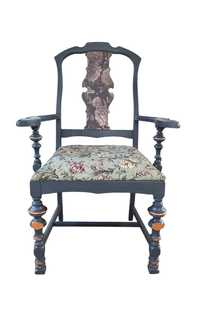
▲ Piece renovated by Max Sanz and Guadalupe Pérez Morales and included in the SillArte exhibition. Photo courtesy of Sanz
Rather than erasing the traces of the past, we sought to keep them alive. We wanted to recover the moment in which they were created, the designs conceived for the fashion and comfort of that era
, he emphasized.
The montage invites you to awaken memories: a family room, your grandparents' house, a movie scene.
These pieces of furniture have always been associated with those who valued detail and quality. Rather than repeating baroque or classical tapestry, we transformed them with contemporary colors and textures
, the artist added.
Restoring and transforming old furniture helped reduce tree felling and prevented it from ending up as trash that takes centuries to decompose, she explained. It was also a sensible economic decision: it's better to invest in something that lasts rather than something disposable
.
For Sanz, the Oaxacan setting gave meaning and nuance to the project. "Here, art is felt in the looms, the clay, the alebrijes... We reclaimed that identity to apply it to pieces that continue to be part of daily life."
We want the public to remember that behind every creation there was someone who thought it through, chose materials and shapes, and who still has something to say today. Chairs hold more than bodies: they hold memories, glances, and even what's left unsaid
, he concluded.
With free admission, SillArte can be visited at the Hotel Casa Cantera (Privada de Reforma 103, Centro neighborhood, Oaxaca).
jornada




